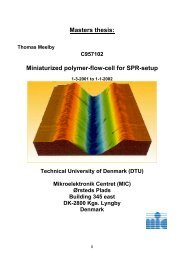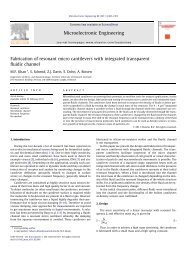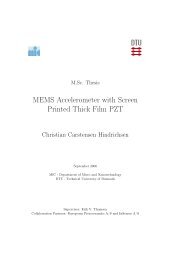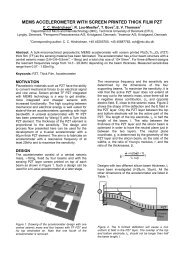Prototyping of microfluidic systems with integrated ... - DTU Nanotech
Prototyping of microfluidic systems with integrated ... - DTU Nanotech
Prototyping of microfluidic systems with integrated ... - DTU Nanotech
Create successful ePaper yourself
Turn your PDF publications into a flip-book with our unique Google optimized e-Paper software.
2 Introduction<br />
that well-established methods were available from the semiconductor<br />
industry, where the miniaturisation <strong>of</strong> <strong>integrated</strong> circuits had been an<br />
ongoing process since the 1970s. In the last decade, however, alternative<br />
materials have been entering the µTAS scene, since both the cost and<br />
the lack <strong>of</strong> compatibility <strong>with</strong> many analytes and chemical environments<br />
make silicon a poor material choice. The interest in polymers has<br />
increased considerably, since a large variety <strong>of</strong> polymers <strong>with</strong> a diversity<br />
<strong>of</strong> properties (chemical, optical, mechanical etc.) is available at a<br />
cost considerably lower than that <strong>of</strong> silicon. Also for industrial scale<br />
production, polymers are processable <strong>with</strong> traditional low-cost methods<br />
like injection molding, which are orders <strong>of</strong> magnitude cheaper than the<br />
clean room processes used when making silicon structures.<br />
The ongoing miniaturisation in consumer electronics further increases<br />
the urge to miniaturise simple analytical <strong>systems</strong> for a number <strong>of</strong> reasons.<br />
An increased focus on and demand for the so-called point-<strong>of</strong>-care<br />
testing <strong>systems</strong> has evolved in recent years. Medical treatment can be<br />
improved if samples can be taken and analysed on-site, rather than<br />
taken to a laboratory. Since the computing power necessary for making<br />
even advanced data analysis is present today in a standard laptop<br />
computer, or even in embedded <strong>systems</strong> in hand-held analytical devices,<br />
the drive to similarly miniaturise the fluidic parts <strong>of</strong> a system is present.<br />
Miniaturising also decreases the amount <strong>of</strong> analyte and reagents needed<br />
to perform a given analysis, thus reducing the cost and environmental<br />
effects when disposing <strong>of</strong> the sample.<br />
1.1 Downscaling<br />
The question that one inevitably poses when looking at the rapid and<br />
constant miniaturisation <strong>of</strong> micr<strong>of</strong>luidic <strong>systems</strong>, is: “When is it going<br />
to end?”<br />
A number <strong>of</strong> very simple practical matters set limits in many areas<br />
<strong>of</strong> the miniaturisation. The dimensions <strong>of</strong> the human hand has set a<br />
limitation to the shrinking size <strong>of</strong> e.g. cellular phones, since the buttons<br />
must have a size comparable to the fingertip <strong>of</strong> the user for the device<br />
to work as intended.<br />
In micr<strong>of</strong>luidics, many applications can theoretically be downscaled<br />
to nan<strong>of</strong>luidics, looking at transport <strong>of</strong> single water molecules through<br />
carbon nanotubes, or similar. Here, the limit to the downscaling is the<br />
molecular scale. For many medical applications, however, the limiting










